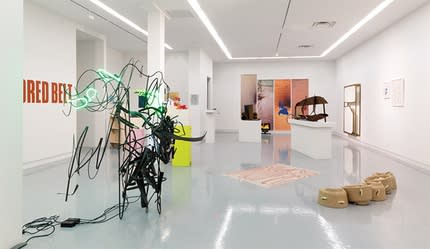Assisted, a vibrant group exhibition curated by Jessica Stockholder, was predominantly installed on the second floor of Kavi Gupta, above Stockholder’s concurrent solo show Door Hinges. Many of the artists included were either Stockholder’s friends or her former pupils; she had selected them based on a mutual interest in the “potential of alternative exhibition modalities.” This theme of nonconformist show organization, stressed throughout Assisted, was introduced with the placement of Tony Tasset’s Cup (2), 2013—a bronze cast, painted white, of a spirally torn Styrofoam cup—atop one of Stockholder’s new ground-floor sculptures. Such a gesture could be read as an extension of Stockholder’s ongoing practice of placing formal elements in dialogue with materials not traditionally valued by high culture (e.g., trash, industrial objects, the presentational apparatus itself)—only here this tactic (itself fairly shaky in the face of the near-evaporation of high/low distinctions) was expanded to encompass a dialogue between the artworks themselves.
Perhaps unsurprisingly for a group of peers with mutual influences, the nature of this conversation, and the exhibition’s dynamic as a whole, was abetted by formal and conceptual similarities. Lurid flourishes of color made their way across many works, including Patrick Chamberlain’s suite of oil-on-birch paintings, stellar Munch, peek a boo, and uninvited guests, all 2015—diminutive Stella-esque geometric exercises partially washed over by hypertrophic, congealing landscapes. Fervors of line and color continue on the gallery floor with Polly Apfelbaum’s ebullient City Lights (off-white with nude spray) and City Lights (purple with blue spray), both also 2015, two scintillating sequin mats marked with softly corkscrewing and wispily zigzagging graffiti. The show’s most vivid palettes, however, came from Stockholder’s own works, particularly sculptures from her Stacks series, 2015–, in which MDF pedestals (some painted in shades of chartreuse, lavender, and vermilion) offer up arrangements of wire mesh, chunky caulk, packaged rope, furniture legs, and other materials one might find in a hardware store. The result is a sort of garish ikebana whose roots appear to be in the realm of industrial manufacturing. Plenty of works reprised Stockholder’s experimentation with form and materials. An example falling in the subtler visual spectrum is Sam Moyer’s Marshall Field’s, 2015, a bronze frame holding inset craggy marble slabs. Its wall mounting and portrait orientation ally the work with the tradition of painting, but its materials are highly sculptural. With Door, 2014, Nancy Lupo took a more playful approach, puzzlingly coating a wall-hung wire rack in kitty litter and epoxy. The so-called experimentation exemplified by the latter work seemed to rest heavily on the impulse to visually induce a simple momentary disorientation or surprise—a methodology that felt less spontaneous and more prescribed as one moved through the gallery.
It’s worthwhile to ask: To what end were these so-called alternative modalities of exhibiting deployed? Altogether, the arrangement of Assisted was governed so clearly by artistic consensus that it reads almost as if the show were curated by algorithm: a series of suggested artworks for you, based on what you’ve already seen. Varying formal modes were employed, but always within a strikingly prescriptive frame. The exhibition’s title references the Latin sistere: to place in spaces or gaps. It is etymologically related to “interstitial,” a word that characterizes Stockholder’s practice of making work “residing” between multiple categories of form. Though some of the experimentation in the show produced compelling results, it appeared generally to merely “reside,” to plug a thematic gap. I had expected a grouping of practices preoccupied with rethinking modes of exhibition to provide a heterogeneous set of strategies characterized by other terms: perhaps dynamism, movement, or even conflict.

